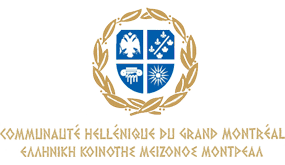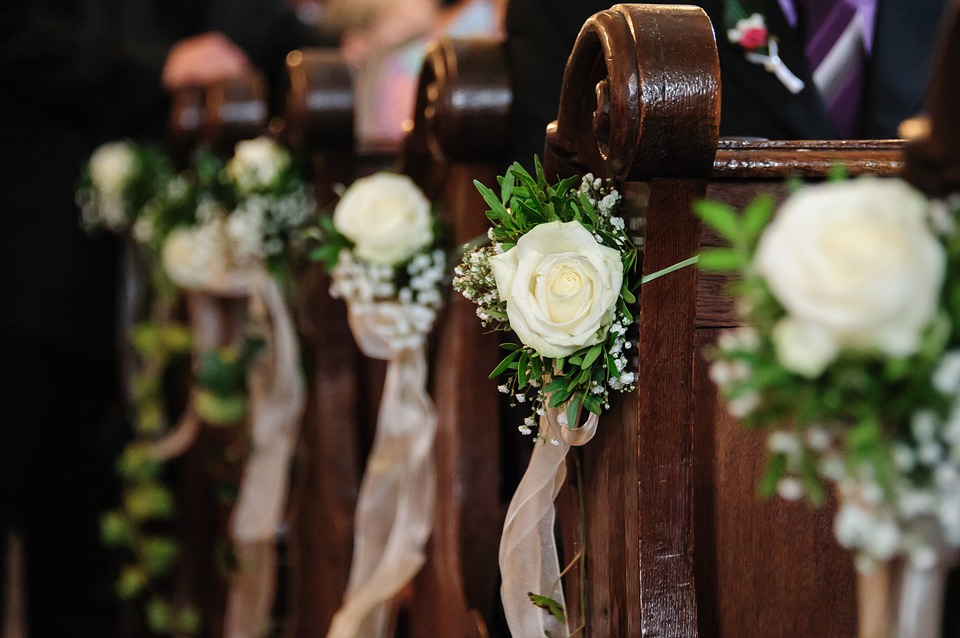
Planning a Greek wedding can be time consuming and challenging. Understanding all of the Greek wedding traditions is a very important part of planning a Greek wedding. Here you will find helpful Greek wedding tips and information about how to plan a Greek wedding.
 The Koumbaros, or “sponsor” of the marriage, plays an important role in the ceremony, performing rituals. Traditionally the groom’s godparent is asked to serve first. Then the godparent of the bride is asked, and then a close friend or family member may be asked.
The Koumbaros, or “sponsor” of the marriage, plays an important role in the ceremony, performing rituals. Traditionally the groom’s godparent is asked to serve first. Then the godparent of the bride is asked, and then a close friend or family member may be asked.
Koumbaros play a much more important role than the American Best Man and Maid of Honor. The Koumbaros are blessed with the honor of later baptizing the first born child. They also act as spiritual mentors and Godparents to the child.
When Greek couples get engaged, they typically exchange engagement rings in the presence of their family. A party follows! Each partner gets a plain gold band to wear on the left hand to signal the engagement. These are the same rings that the couple will wear as their wedding rings. The bands are blessed during the wedding ceremony, and then the couple switches them to the right hand.

 In setting the date, there are traditional times of year when the Greeks would never hold a wedding ceremony. Most Greeks belong to the Greek Orthodox Church and get married in that faith
In setting the date, there are traditional times of year when the Greeks would never hold a wedding ceremony. Most Greeks belong to the Greek Orthodox Church and get married in that faith
The forbidden dates for weddings include the first two weeks of August because that is a time devoted to celebrating the Virgin Mary. Greeks also do not get married during the forty days preceding Christmas. And the entire period of Lent – the somber period forty days leading up to Easter – is also not acceptable for weddings. There are a few other holy days where weddings will also not be performed. These include August 29th, which marks the beheading of Saint John the Baptist, and September 14th, which is the celebration of the Exaltation of the Holy Cross.
If you wish to have your wedding ceremony at one of the HCGM Churches, feel free to contact the Church secretary and reserve a suitable date. In collaboration with the Church secretary, get all the necessary information for the required documents.
 Before the wedding, friends and family will help the new couple prepare their new home. The bride and her attendants – all single women – will make up the marital bed. The groom must give it his official approval. Then money (for prosperity) and rice (for putting down roots) are thrown on the bed. Lastly, a baby is rolled across the bed to guarantee fertility! Superstition says that whatever the sex of the baby is, will be the sex of the couple’s first child. So if a boy is used, their first child will be a son.
Before the wedding, friends and family will help the new couple prepare their new home. The bride and her attendants – all single women – will make up the marital bed. The groom must give it his official approval. Then money (for prosperity) and rice (for putting down roots) are thrown on the bed. Lastly, a baby is rolled across the bed to guarantee fertility! Superstition says that whatever the sex of the baby is, will be the sex of the couple’s first child. So if a boy is used, their first child will be a son.
 On the day of the ceremony, the groom’s friends will gather to help him get ready. His best man – called the “koumbaro” – will shave the groom. This shows the trust between them. The koumbaro will also stand by the groom during the ceremony, and has other obligations like procuring the wedding crowns. All the other friends present help to dress the groom. One might button the shirt. Another might put the jacket on him. That way they all have a symbolic role in getting him ready.
On the day of the ceremony, the groom’s friends will gather to help him get ready. His best man – called the “koumbaro” – will shave the groom. This shows the trust between them. The koumbaro will also stand by the groom during the ceremony, and has other obligations like procuring the wedding crowns. All the other friends present help to dress the groom. One might button the shirt. Another might put the jacket on him. That way they all have a symbolic role in getting him ready.
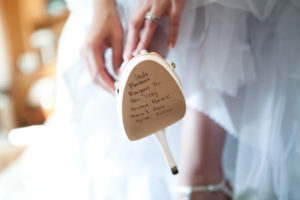 The bride is similarly prepared by her koumbara – or maid of honor – and dressed by her friends. On the bottom of the bride’s shoes are written the names of all her unmarried friends. The names that get worn away by the end of the night are the names of the women who will be married soon themselves. The bride, once she is dressed, traditionally leaves with her father. She is told by her mother to look back at her parents’ house one last time to ensure that the children take after that side of the family.
The bride is similarly prepared by her koumbara – or maid of honor – and dressed by her friends. On the bottom of the bride’s shoes are written the names of all her unmarried friends. The names that get worn away by the end of the night are the names of the women who will be married soon themselves. The bride, once she is dressed, traditionally leaves with her father. She is told by her mother to look back at her parents’ house one last time to ensure that the children take after that side of the family.
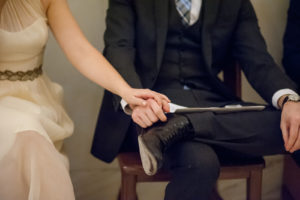 Together, the couple must also meet with the priest at their local church. They are required to meet a few times during their engagement to ensure that they are ready for marriage and know what to expect.
Together, the couple must also meet with the priest at their local church. They are required to meet a few times during their engagement to ensure that they are ready for marriage and know what to expect.
The Wedding Ceremony
The wedding ceremony of the Greek Orthodox Church is an ancient and evocative service by which a man and a woman are united together "In Faith, and in Oneness of Mind, in Truth, and in Love", acknowledging that their love is rooted in God, who is Love itself. The marriage ceremony is abundant with symbols that reflect the basic and important elements of marriage: Love, Mutual respect, Equality and Sacrifice.
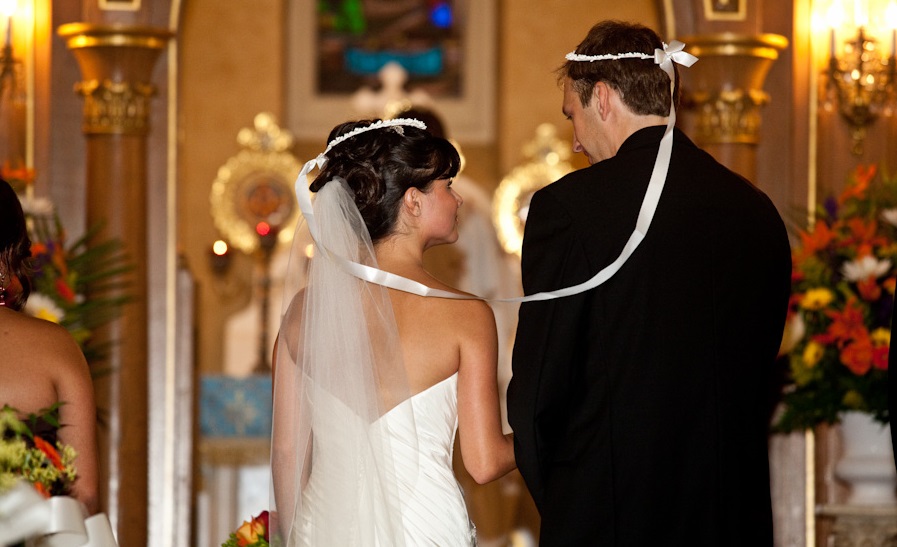 The Traditions observed today have special meanings and significance. These symbolic actions are often repeated three times stressing the belief in the Holy Trinity, in which God is represented as the Father, the Son, and the Holy Spirit.
The Traditions observed today have special meanings and significance. These symbolic actions are often repeated three times stressing the belief in the Holy Trinity, in which God is represented as the Father, the Son, and the Holy Spirit.
In the Orthodox tradition, the wedding ceremony is actually composed of two services. The first is the Service of Betrothal, or Engagement ceremony, during which the rings are exchanged. The second is the Service of Marriage or Crowning, during which prayers are offered for the couple, the crowns of marriage are placed on their heads, the common cup is shared, and the ceremonial walk takes place around the table.
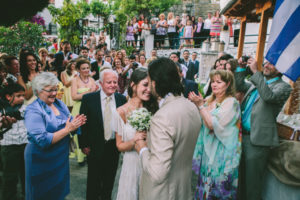 In the Greek Orthodox Tradition, the father accompanies the bride to the entrance of the church, where the groom awaits with her bouquet. The groom offers the bouquet to her, and takes her right hand after her father. Bride and groom then walk together down the aisle, the groom on the right side of the bride. There they are awaited for by the koumparo and koumpara, who will exchange the wedding rings and the wedding crowns.
In the Greek Orthodox Tradition, the father accompanies the bride to the entrance of the church, where the groom awaits with her bouquet. The groom offers the bouquet to her, and takes her right hand after her father. Bride and groom then walk together down the aisle, the groom on the right side of the bride. There they are awaited for by the koumparo and koumpara, who will exchange the wedding rings and the wedding crowns.
In this service, the priest begins by offering petitions of prayer on behalf of the man and woman who are being betrothed. He then asks God's blessings upon the rings and proceeds to bless the bride and groom with the rings. He does this three times in the Name of the Father and the Son and the Holy Spirit, first from the groom to the bride, and then from the bride to the groom. The back and forth movement can be interpreted to mean that the lives of the two are being entwined into one. Double wedding bands are used, since according to Old Testament references, the placing of rings was an official act indicating that an agreement had been sealed between two parties. In this case, the agreement is that a man and a woman agree to live together in the fellowship of marriage as husband and wife.
 The priest then places the rings on the ring fingers of the right hands of the two. It is noteworthy that the right hands are used in the putting on of the rings, since according to all Biblical knowledge we have, it is the right hand of God that blesses; it was to the right hand of the Father that Christ ascended; it is to the right that those who will inherit eternal life will go.
The priest then places the rings on the ring fingers of the right hands of the two. It is noteworthy that the right hands are used in the putting on of the rings, since according to all Biblical knowledge we have, it is the right hand of God that blesses; it was to the right hand of the Father that Christ ascended; it is to the right that those who will inherit eternal life will go.
The rings are then exchanged three times on the fingers of the bride and groom by the Best Man (koumbaro) a further expression and witness that the lives of the two are being brought together. The exchange signifies that in married life, the weakness of one partner will be compensated by the strength of the other. Apart, the newly betrothed are incomplete, but together they are made perfect.
A final prayer is read which seals the couple's acceptance of the rings, and asks that this mutual promise of betrothal, officially given before the church, may prove in true faith, concord, and love. The rings are then exchanged three times on the fingers of the bride and the groom by the Sponsor A final prayer is read, sealing the putting on of the rings, which then take on the added meaning that the agreement was sealed and that the marriage was enacted by God Himself. The couple is now engaged to be married before God.
The Service of Crowning / The Sacrament of Marriage
The Sacrament of Marriage begins immediately following the Betrothal Service. The priest hands the bride and groom white candles that symbolise the couple's spiritual willingness to receive Christ in their life. Two candles are lit, one each for the bride and groom, and the light from the candles represents the spiritual willingness of the couple to receive Christ, the "Light of the World", into their lives together.
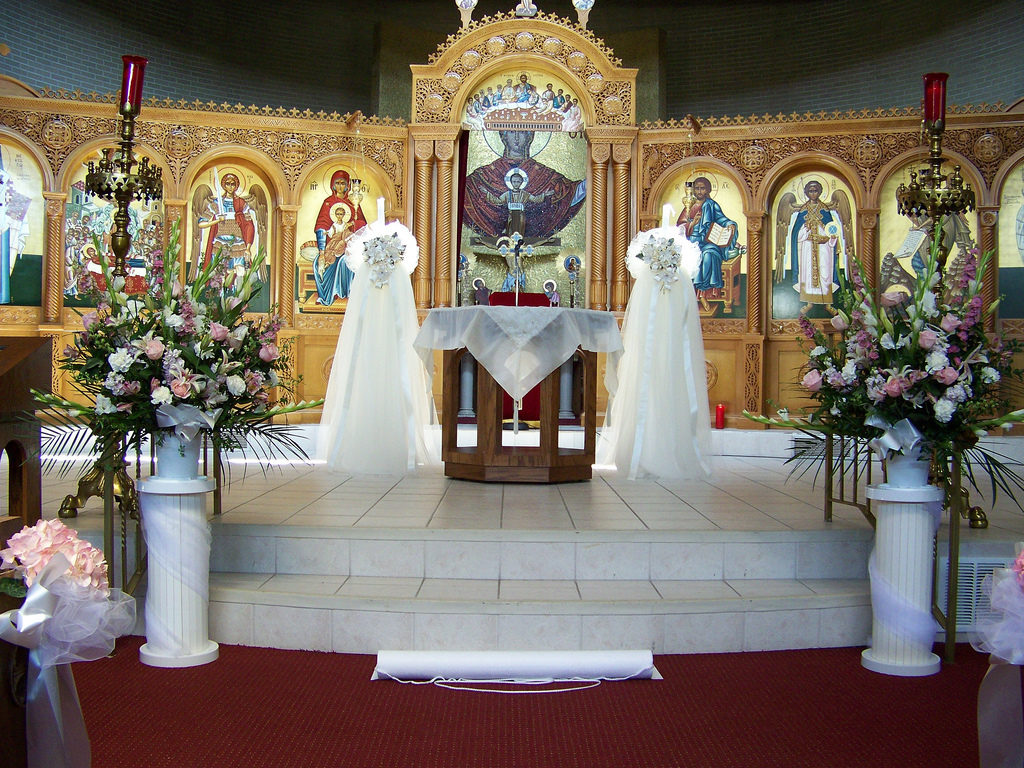
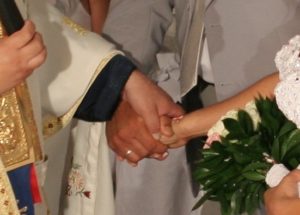 The Sacrament continues with the invocation of the Holy Trinity. After petitions are offered on behalf of the bride, groom and wedding company, three prayers are read which ascribe to God the institution of marriage and the preservation of His people through the ages. These prayers portray humanity as one continuous fabric, in which is interwoven everyone from the first man and woman, Adam and Eve, to the present generation of believers. The bride and groom enter into this fabric with the reading of the third prayer.
The Sacrament continues with the invocation of the Holy Trinity. After petitions are offered on behalf of the bride, groom and wedding company, three prayers are read which ascribe to God the institution of marriage and the preservation of His people through the ages. These prayers portray humanity as one continuous fabric, in which is interwoven everyone from the first man and woman, Adam and Eve, to the present generation of believers. The bride and groom enter into this fabric with the reading of the third prayer.
 The Crowning is the highlight and focal point of the Sacrament of Holy matrimony. The priest then takes two wedding crowns, or Stefana, and blesses the bride and groom in the name of the Father, and the Son, and the Holy Spirit, and then places the crowns upon their heads. The Koumparos or Koumpara then interchanges the crowns three times as a witness to the sealing of the union.
The Crowning is the highlight and focal point of the Sacrament of Holy matrimony. The priest then takes two wedding crowns, or Stefana, and blesses the bride and groom in the name of the Father, and the Son, and the Holy Spirit, and then places the crowns upon their heads. The Koumparos or Koumpara then interchanges the crowns three times as a witness to the sealing of the union.
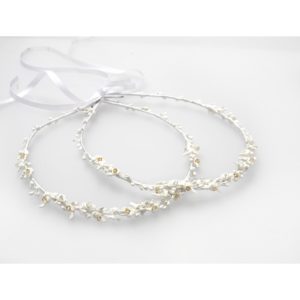 The wedding crowns, or Stefana, symbolize the glory and honor that is being bestowed on them by God during the sacrament. The Stefana are joined by a ribbon which symbolizes the unity of the couple and the presence of Christ who blesses and joins the couple. Through the crowns, the Christ establishes the couple as the King and Queen of their home, which they rule with wisdom, justice, and integrity. The crowns used in the Orthodox wedding ceremony also refer to the crown of martyrdom, since every true marriage involves self-sacrifice on both sides.
The wedding crowns, or Stefana, symbolize the glory and honor that is being bestowed on them by God during the sacrament. The Stefana are joined by a ribbon which symbolizes the unity of the couple and the presence of Christ who blesses and joins the couple. Through the crowns, the Christ establishes the couple as the King and Queen of their home, which they rule with wisdom, justice, and integrity. The crowns used in the Orthodox wedding ceremony also refer to the crown of martyrdom, since every true marriage involves self-sacrifice on both sides.
The crowning is followed by a reading of the Gospel, which tells of the marriage of Cana at Galilee. It was at this wedding that Jesus performed His first miracle, changing water into wine, which was then given to the married couple, symbolizing a transformation from old into new, a passage from death into life. In remembrance of this blessing, following the Gospel reading and brief prayers, a cup containing a small portion of wine is presented to the bride and groom. The wine is blessed by the celebrant and offered to the now wedded husband and wife, and they each drink three times from a "common cup".

The common cup serves as a witness that from that moment on, the couple shall share everything in life, joy as well as sorrow, and that they will bear one another's burdens, the token of a life of harmony. Their joy will be doubled and their sorrows halved because they are shared. Whatever the cup of life has in store for them, they will share equally.
The priest then takes the arm of the groom and leads him and his bride around the table three times as an expression of joy. The three-fold walk around the anti-altar is seen as a religious dance. In this respect it is an expression of gratitude to God for His blessings, and joyfulness at the receiving of those blessings.
As the bride and groom are led around the table three times, three significant hymns are sung. The first speaks of the indescribable joy that Isaiah the Prophet experienced when he envisioned the coming of the Messiah upon the earth. The second reminds us of the martyrs of the Faith, who received their crowns of glory from God through the sacrifice of their lives, and reminds the newlyweds of the sacrificial love they must have for one another in their marriage. The third is exaltation to the Holy Trinity.
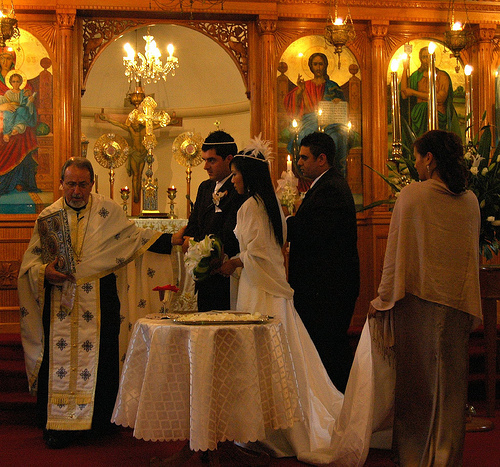
The altar contains the cross and the holy gospel, and on each circle, the couple kisses the cross that the priest holds. The circular movement represents peacefulness and infinity, towards which the couple engages, the cross represents suffering, and the gospel represents the education of children to come. The bride and groom take their first steps together as a married couple, and the priest represents the Church, leading them in the direction in which to walk.
At the conclusion of the ceremonial walk, the couple returns to their places. The priest blesses the groom and then the bride as he removes the crowns from their heads, and implores God to grant to the newlyweds a long, happy, and fruitful life together.
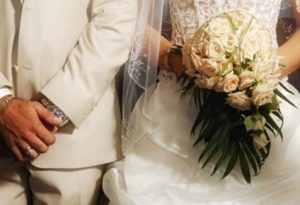 When the bride and groom have returned to their original places, the Priest faces the groom and says: "Be magnified, O Bridegroom, as Abraham, and blessed as Isaac, and increased as was Jacob. Go your way in peace, performing in righteousness the commandments of God." Turning to the bride, he says, "And you, O Bride, be magnified as was Sarah, and rejoiced as was Rebecca, and increased as Rachel, being glad in your husband, keeping the paths of the Law, for so God is well pleased."
When the bride and groom have returned to their original places, the Priest faces the groom and says: "Be magnified, O Bridegroom, as Abraham, and blessed as Isaac, and increased as was Jacob. Go your way in peace, performing in righteousness the commandments of God." Turning to the bride, he says, "And you, O Bride, be magnified as was Sarah, and rejoiced as was Rebecca, and increased as Rachel, being glad in your husband, keeping the paths of the Law, for so God is well pleased."
Then, removing their crowns, the Priest says, "Accept their crowns in Your Kingdom unsoiled and undefiled; and preserve them without offense to the ages of ages." The priest then lifts up the Gospel and separates the couple's joined hands, reminding them that only God can separate the couple from one another. This gives emphasis once again to their oneness and to the holiness of their union. "What God has joined together, let no man put asunder."
As the married couple exits the church they are bombarded with rice. (for putting down roots)
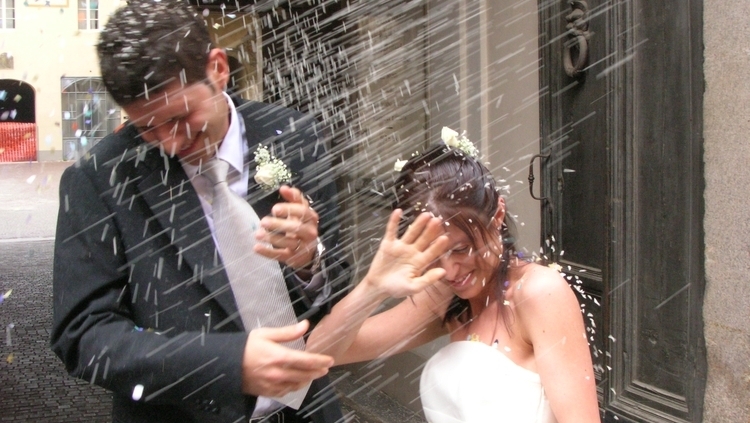
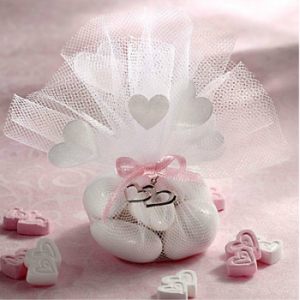 Each guest should leave with a small bag of Jordan almonds, or koufeta. There will naturally be an odd number of almonds in the bag – for luck! The almond itself tastes slightly bitter, but the sugar-coating is a way of wishing the couple’s life will be mostly sweet. (In olden days, nuts were simply dipped in honey and eaten.) The egg-shaped almond also symbolizes fertility. And its crunchy hardness is a symbol of the endurance of the marriage! A single person can place the almonds under his or her pillow and should dream that night of the person they will marry.
Each guest should leave with a small bag of Jordan almonds, or koufeta. There will naturally be an odd number of almonds in the bag – for luck! The almond itself tastes slightly bitter, but the sugar-coating is a way of wishing the couple’s life will be mostly sweet. (In olden days, nuts were simply dipped in honey and eaten.) The egg-shaped almond also symbolizes fertility. And its crunchy hardness is a symbol of the endurance of the marriage! A single person can place the almonds under his or her pillow and should dream that night of the person they will marry.
